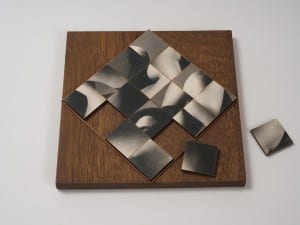Translating personal experiences into hyperreal images, the renowned photographer is celebrated through a mid-career survey and monograph.
Alex Prager (b. 1979) became a photographer overnight. After first picking up a camera at the age of 21, and before any gallerist in the world knew her name, she anonymously hung pictures in the laundry room of her apartment building in Los Angeles. Some of the pieces were stolen by people who had found a sense of connection with the work whilst waiting for the spin cycle to end. It provided an early lesson – the kinds of visual works that inspire, excite and engage people are the types that touch upon a particular moment in time. The compositions she had staged – choreographed and planned – were taken more frequently than momentary snapshots of passers-by; those that most transfixed viewers were those that were intimate, cryptic and intentional.
Prager’s practice evolved after she came face to face with an image by William Eggleston at the J. Paul Getty Museum, Los Angeles. She notes: “Within a few days, I bought everything I needed to become a professional photographer.” Spending $80 on darkroom equipment from eBay, she unloaded savings on a professional camera – a Mamiya 645, which uses Kodak Portra colour negative film.
In an interview from the monograph Silver Lake Drive – published by Thames & Hudson – Prager recalls the early days, and the first encounters with canonical artworks that have shaped her unique way of thinking. “My mentor gave me this advice: if I wanted to be a professional photographer, then for the first two years I shouldn’t speak to any other practitioners. This way, I would be able to develop my own style, and not just learn about all the rules.”
Self-taught and devoid of formal training, she came to obsess over the fine details of the imagination, spending hour upon hour on the streets, trying to emulate in her own way the small, strange and dramatically potent moments she had discovered in Eggleston’s metropolitan scenes. She continues: “I would photograph until three in the morning and then work in my darkroom until six, so I could immediately process my film. I had to go work at 9am. I came home from work at 6pm and would go back out with my camera.”
As time went on, other influences started to coalesce in her work. She bought books about the New York street-lurkers Diane Arbus and Weegee, spending massive amounts of time reading about their ability to capture strangers at their most expressive, performative and vulnerable. Although unaware of her influences at the time, echoes of Cindy Sherman’s unvarnished understanding of femininity, and Gregory Crewdson’s dark, faux-glamorous take of the American suburbs can also be found within the stretches of her imagination.
The cinematic elements for which Prager is widely celebrated chart back to a childhood spent in Los Angeles. The glamorous exteriors of the city, as well as its seedy underbelly, seep through the aesthetic of her pieces, with subtle references to Alfred Hitchcock, Douglas Sirk, or the Mulholland Drive strain of David Lynch. In this sense, the early work moved away from the serendipitous, uncontrolled essence of the sort of street photography practised by Eggleston and Arbus, and towards a more staged, controlled and hyperreal aesthetic. In a 2017 interview with Flaunt magazine, she said of the link between street and staged photography: “Whilst practitioners like Eggleston find their perspective in characters already on the streets, I create mine. Someone like Bruce Gilden might have an instinctual angle when he sees a character coming towards him, but ultimately, we’re all just looking for the right moment. I just do so within a controlled environment.”
How many artists can tell such a story, and claim such a moment of singular inspiration and organic, discovery-led approaches? But, then again, how many can point to a career as successful as that of Prager, who is about to have a mid-career survey at The Photographers’ Gallery, London – a four-month-long solo exhibition spanning two floors of the Soho gallery. The exhibition, which shares the title Silver Lake Drive with the monograph, has been years in the making, and encompasses over 40 works – including her trademark, large-scale Technicolor compositions – alongside complete film works up until La Grande Sortie, a short created for the Paris Opera in 2015.
Curated by Nathalie Herschdorfer, it is produced in collaboration with the Museum of Fine Arts Le Locle and Lehmann Maupin, New York. The book and exhibition use the 2007 series Polyester as a starting point, a collection of laboriously poised yet colour-driven portraits of young femininity on the urban streets of Los Feliz. The series was first exhibited at Robert Berman Gallery, Santa Monica, a solo show for the then 28-year-old, who, at that point, had only appeared in a few group shows. It was a huge vote of confidence, but, as Berman stated: “Her work is very reminiscent of another time. It’s both comforting and uneasy, and that dichotomy throws you off guard.” Berman was also struck by the understanding of colour palettes, noting: “Alex’s photographs are more about the arrangement of colour than about the subject.”
Polyester oozed the synthetic glamour of life in Los Angeles and was full of visual references to Hollywood studio storytelling – specifically, how they used the bright Californian sun, even when telling the darkest stories. “I love the lighting from Hollywood movies of the Golden Era, from the movies of the 1920s until the 1950s,” Prager once remarked. “With that kind of lighting, anything can happen. It draws you in. There can be a lot of dark things happening – things that might not have been pleasant to watch, but the lighting aestheticises them and makes watching the movie irresistible.”
From Polyester onwards, the rise in the artist’s profile and prestige was vertiginous. The following series, titled The Big Valley, was shown in 2008 at Michael Hoppen Gallery, London, and in 2009 at Yancey Richardson Gallery, New York. In 2010, at New York’s MoMA, she was included as part of the highly influential New Photography exhibition and by 2012, she had netted an Emmy for her New York Times-commissioned video series Touch of Evil, as well as securing projects with Hollywood stars like Gary Oldman and Rooney Mara, and seen her work housed permanently at MoMA, Whitney Museum, SFMOMA and Moderna Museet, Stockholm.
As a growing profile began to escalate, so Prager’s work started to take on a more monumental style – a spectacle of action, colour, gesture and detail. Face in the Crowd, perhaps one of the best-known collections, debuted at Washington DC’s Corcoran Gallery of Art in 2013. Shot in a Hollywood studio, the compositions involved painstakingly re-building the kind of public spaces in which people typically congregate and share in the city – streets, movie theatres, beaches and airports.
“Sometimes I find people on the street or in restaurants,” she says of casting for the works. “I’ll walk up to people if I feel like they have something really special that sparks my imagination – the colours they choose to wear, or the way they style their hair. There are reasons why people do these things before they leave the house. It’s a way of communicating who they are.” For the pieces, she used up to 350 models for a single shot, often bringing in a combination of friends, relatives and models found through agencies. The production team swelled up to 70 people, and each subject is carefully dressed and made-up before the shoot begins, so a very clear and recognisable tone is created in each image.
With more than 400 people on set, the settings resemble a large-scale Hollywood film production, yet Prager sees in this approach a clear lineage to her formative experiences out on the streets: “You can view my photography as hyper-constructed and detailed,” she continues, “but I only control it all the way up until I get ready and everyone is on set and waiting for it to start. Then, within that, I find the street moments where nothing is planned. You can’t really control people. You can put a layer of costume on them, but once you begin, they have their own emotional baggage and they have their aspirations causing them to come to set that day. All kinds of weird, interesting stories start to float to the surface. Those are always the best moments that come through.”
For all the cinematic prowess and high-production values of the most recent works, the themes Prager explored with Polyester – of women engaging with feelings of isolation, dislocation and vulnerability – still remain incredibly prevalent. She has indeed spoken of how the women in front of the lens serve as avatars for the projection of her personal emotional experiences. “I focus on women who I can use to emulate what I am going through myself,” she notes in Silver Lake Drive. “The stories I’ve made so far are about emotions.” Face in the Crowd was about stage fright, she reveals: “I was travelling a lot at one point and often felt alone amongst strangers. I was questioning my own reality, how I perceived those who were around me, and how they viewed me. A lot of my work is about perception: how the lines between what is real and what only feels real can become blurred.”
Speaking to Aesthetica, The Photographers’ Gallery curator Herschdorfer says: “Each of Prager’s subjects are linked by their ability to communicate very strong emotions. She can use many different mediums and languages – still and moving image, fashion and costume, personal and commissioned work – but the focus on female characters, and their psychological states, remains constant.” It is clear that Prager has grown with the camera. Whilst at first glance the pieces might seem like odes to the classic movies made from the city, referencing a Los Angeles life of make-believe, they are, in fact, piercingly honest self-portraits.
“This is a survey of more than 10 years of work,” Herschdorfer says. “If you look at the early series, the subjects are indeed very young at first. But, in the later pieces, the characters are closer to her age. Photography is used to follow life. The experience she has as a woman, and the memories she carries with her, are shared through the compositions.”
The beginning of Prager’s career is remarkable, as was her willingness to learn about photography intuitively, in a way that seemed to consciously turn its back on any of the conventional teaching methods that often pervade the industry. But without this approach, Herschdorfer says, the photographer would not be who she is today – a fascinating and ground-breaking practitioner. “She’s not educated in art; she learnt to listen to her own feelings. Then she found out how to share them. That’s the most important thing in the world.”
Tom Seymour
Silver Lake Drive runs 15 June -14 October at The Photographers’ Gallery, London.
Monograph published by Thames &Hudson. www.thamesandhudson.com.
www.thephotographersgallery.org.uk.










